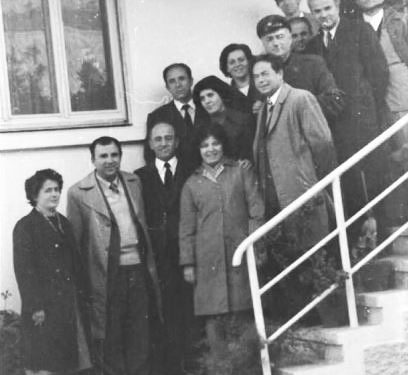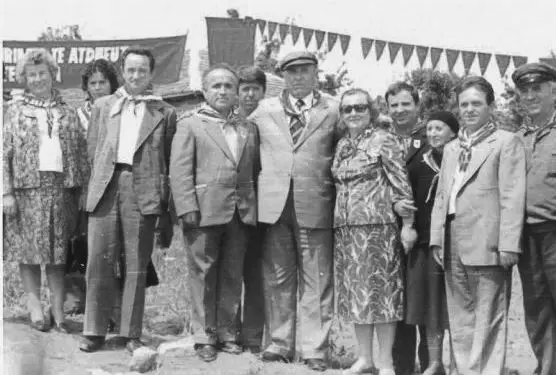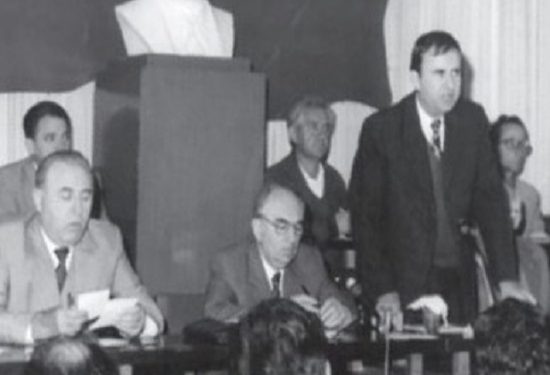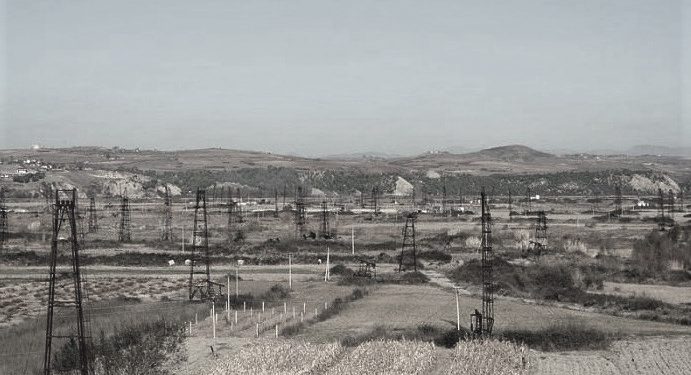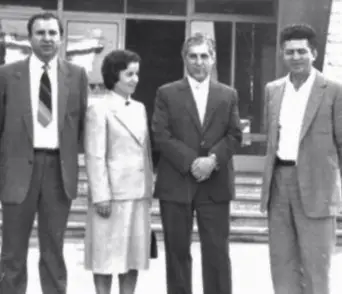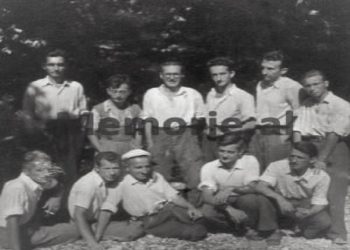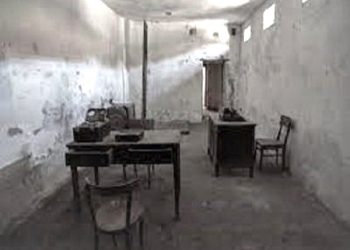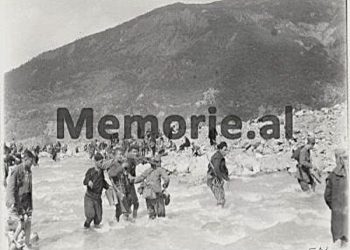By Agron Cuedari
The first part
-Four years of work as a director, at the Oil Refinery Plant in “Stalin City”-
Memorie.al / The processing of crude oil, for the extraction of by-products from it such as fuels, fuels, bitumen, etc., so precious for the development of a country’s economy, is also early in our country. The first refinery in our country (distillery), with a small processing capacity, was established by the concessionaire company AIPA, since its discovery of the first oil source in Kuçovë, in 1935. Another refinery was also built in Kuçovë by the German occupiers in 1944, but at the time she was being commissioned, she was attacked and destroyed by British aviation bombing.
After the liberation of the country, with the re-use of the oil field destroyed during the war, in the early 50s of the last century, the first new oil processing refinery was built in the city of Stalin, with a capacity of 200 thousand tons per year, located on the hillside to the north-west of the city. With the establishment and commissioning of this refinery, later named the “UPN” Oil Refinery, the dedicated work of Russian engineers and a group of Albanian engineers, who had studied in Russia and Romania and, in particular, stood out of Albanian workers, who had worked together with Italian specialists in the refinery set up by the AIPA Company.
It was this same group of Albanian engineers and old and new specialists who worked at UPN that, then, at the end of the 1950s, set up and put into use the Oil Refinery in Cerrik, in 1960, the one in Fier as well as in 1975, together with Chinese specialists, the Deep Oil Processing Plant in Ballsh. All these plants in 1976 had an oil processing capacity of up to two million tons per year, as much as its extraction in our oil fields. Although I did not oppose my appointment to the position of Director of the Oil Refinery, inside myself, in the first days of work, I was in a dilemma and not a little worried.
This, firstly, that my education was not that of the technological profile of oil processing and, secondly, for this plant, especially in the last two years, I often heard public criticism from the party bodies in the region and the executive bodies in Berat, for the lack of completion of oil processing plan tasks. When I started work in September 1972, I found all the employees fully engaged and focused on two fronts: that of fulfilling the tasks of oil processing in the existing plants and departments and that of the construction works to increase the processing capacity of the plant, from 200 thousand to 500 thousand tons per year. The construction works were focused on the construction of a new oil processing plant, on the construction of a new factory for the production of bitumen packaging barrels, on the addition of deposits in the storage parks of crude oil and fuels, as well as on the expansion and improving the working conditions in the premises of the bitumen department.
In the first days of work, I focused mainly on following the progress of the construction problems carried out by the Oil Installations Construction Company. The objective was to complete these works within the month of December. Every evening, together with the managers of the construction site, we gathered at the facility. We discussed the progress of daily work, according to the approved schedule, and recorded the state of the material base. The General Directorate of Petroleum in Fier had opened the doors of its warehouses in Patos, as well as that of reserves in Karnica of Fier. In the daily meetings with the heads of the administration branches every morning in my office and during the day with the technologists, plant shift operators and department heads at their workplaces, I felt good when they reported to me that the works in the plant were going well and, for each day the tasks were carried out according to the plan.
When I asked them why, when things were going so well, the plan was not implemented, they answered that during the year the main plant, the oil processing one, was often stopped and that these forced stops were caused by the non-evacuation of the finished sub-products from the plant and for lack of sheet metal used for bitumen packaging. Not that I didn’t believe what they told me, but in order to know how true the impact of these bans was on the non-realization of oil processing, I tasked the heads of the administration branches to extract from the blocks the operational data that they evidenced in every shift, the operators of the plant, as well as the hours and days of stoppages in the last two years 1971 and 1972. From the verification of these data, it turned out that during 1971, for these two reasons, the plant was stopped eight times, which were calculated in 18 days lost jobs. For the six-month period of 1972, the plant was shut down five times, accounting for 12 lost work days. If these stops had not happened, the oil processing plan at the plant in both years would have been realized to the extent of more than 100%.
Based on these data, in my point of view, I judged that the responsibility for the non-fulfillment of the plan did not fall on the factory’s employee collective, or on the engineering-technical personnel and department heads. It all fell on the plant’s administration, especially on the former director who left and the heads of the planning, supply-distribution and finance departments. In the meeting I had with the administration employees about this problem, I found out from the archive office that no analysis had been done and no responsibility had been taken for these stops and there was no correspondence with the contracting companies: the transport park at Ura Vajgurore, the fuel branch what about the Vajgurore Bridge or the material-technical supply base for oil in Patos. No lawsuit in the high state arbitration, or any official document in the General Directorate of Oil in Fier, as well as those of the district in Berat.
Convinced that with those early branch heads in those tasks and acclimatized to that situation, it would be difficult 89 Confessions and impressions to cope with the tasks of the 1973 plan and the following years, when the plant would no longer process 200 thousand tons per year, but 500 thousand tons, I asked all three to resign. With the approval of the Party Committee for their release and the appointment of three economists, young men, one employee at the factory and the other two with jobs in the local government institutions in Berat, my hopes were raised that the administration of the factory would rise at the level it needed to be at the forefront of things. Without neglecting the works at the plant and, in particular, the progress towards the completion of the construction works on the new additional facilities, anxious about the successful start of the works in the month of January 1973, I went and contacted the managers of the enterprises that were connected with as every year, with contractual obligations for the evacuation from the plant of fuels, fuels, bitumen and insurance from the import of sheet metal for bitumen packaging.
Not to argue with them about the obstacles they had caused us during 1972, but especially to know about the preparations they had made for the tasks of the first quarter of 1973, which were 2.5 times higher than those of 1972. In the freight transport park located in Ura Vajgurore, which was subordinate to the Ministry of Transport, they knew that the quotas would be increasing, but as far as they were aware, the additional vehicles would come from import during the first quarter of the year other. In the branch of the fuel park, located in Ura Vajgurore, under the Ministry of Internal Trade, they did not know anything about the fuel quotas they would receive from us during 1973. They were not given any investment for the increase in the number of deposits. .
The warehouses were full of fuel and they would be full even in January, because in the winter period especially agriculture used less. At the Metal-Import Enterprise in Tirana, under the Ministry of Foreign Trade, I was told that the sheet metal for bitumen packaging planned for the first quarter, would arrive in Albania in February 1973. Extremely worried about this situation, upon returning to the plant, I sent a letter to the General Directorate of Oil in Fier, the Executive Committee of the Berat district and a brief information to the Party Committee of the Region, where I informed them of the serious situation and difficulties that would be created in the plant for the successful start of work in the month of January. I detailed these problems above to show elsewhere how they were solved.
Through a telephone conversation a week later, from the letter I had sent to Lipe Nashi, General Director of Nafta in Fier, he informed me: “You will do the year-end analysis in the company on December 20. In that meeting, we will also talk about the concerns you raised in the letter. Prepare well that there is a possibility that one of the friends of the Political Bureau will also participate in that meeting”. Indeed it happened. In that analysis, the member of the Political Bureau and the Chairman of the Sheti Plan Commission, Abdyl Këllezi, accompanied by the General Director of Nafta, the Chairman of the Executive Committee of the district and the First Secretary of the Party Committee of the Region Emine Guri came to the plant. To wait for them at the appointed time, the administration employees, engineering-technical personnel, heads of departments and many distinguished workers gathered in the red corner of the plant. In my opening speech, after thanking Avdyl for his participation for the first time in that plant, through a short report, I informed him about the progress of the work during the year.
In a spirit of self-criticism on behalf of all the employees of the plant, I took full responsibility for the failure to complete the tasks of the 1972 plan. I then turned to the preparatory work and the measures we had taken to begin the full work on the year’s tasks. 1973. I informed him that we had completed on time and successfully the construction works for the construction of new plants and the expansion of activity in the existing departments, for the increase of the capacity of the plant from 200 thousand to 500 thousand tons in 1973, that in those plant we had completed all the approval tests and were ready to start on January 1st. Before I sat down, I asked Abdyli to let me inform him about some difficulties that would be created for us by the enterprises connected with us, for the evasion of finished by-products and the provision of sheet metal for bitumen packaging.
I told him that, while at our plant during the years 1971-1972, investments had been made and work had been done on the construction of additional facilities to increase the processing capacity, in these enterprises which had the task of withdrawing bitumen fuels from the plant, no investment was made during 1972; that also, with the current state they had 91 Confessions and impressions after conversations with their leaders, I found it very difficult for them to support us for the commissioning of the two plants in January. I told him that in the goods park; additional vehicles would arrive from import during the first quarter, that in the fuel branch the deposits were full and that the sheet metal would be brought by Metal-Import in February. Consequently, I emphasized that, in my opinion, the responsibility for this situation was the responsibility of the relevant ministries which had not well coordinated the work between them that just like us, and those enterprises should have been ready in December for the tasks of the month of January and ongoing.
In the end I asked him for help to remedy that situation. As far as I noticed when I sat down, these concerns of ours were not raised by the Director General of Nafta, because I saw him surprised, worried and nervous. “I didn’t come here to take lessons from you,” he told me. – Here you have the General Director and the Chairman of the Executive Committee. Engage together to solve these problems, because within the district you have these enterprises”. His nervousness reached its peak when, on leaving the hall, he could not contain himself and hit the door with his fist. After I broke up with him, I was somewhat worried and we debated with ourselves, whether I did the right thing in telling him without hesitation and directly in the face of the responsibility of the ministries, which indirectly also fell on him, being that as Chairman of the Plan Commission that was, it was his duty to coordinate and control the work of the departments for the realization of the state plan.
My worry did not last long. All of a sudden, when I couldn’t even believe my eyes, three days later, 100 tons of sheet metal for bitumen packaging arrived at the plant from the State Reserves, enough for the time when the planned import quantity would arrive. By an order of the Ministry of Transport, the goods park in Uran Vajgurore, two or three days before the new year, 30 vehicles with all drivers arrived from the parks of other districts, transferred for a period of three months, until the arrival of vehicles scheduled for import. The Ministry of Internal Trade, with a concentrated action, evacuated from the fuel branch in Ura Vajgurore all the amount that was in storage and sent it to the state reserve warehouses. On January 1, 1973, the plant was put into operation at full capacity. Good start, half the job. Everything after that regarding the progress of the works and the realism of the plan fell on us, all the employees of the plant and especially on me as the director.
Departments, plants and their activity: – The main crude oil processing department in the plant had two plants AVT-1, AVT-2 (AVT= Atmosphere-Vacuum-Temperature, in the language used by specialists). The technology used in them for oil processing was the classic one, which has as its principle the process of distillation, of separation during the boiling of crude oil at temperatures of 330-360°C, of condensed gases according to specific gravity that flow from the atmospheric column in semi-finished, named gasoline, kerosene for burning and lighting, kerosene for aircraft and gasoil (in the language of diesel drivers). The fuel oil, which is taken from the bottom of the atmospheric column, is sent to the vacuum column, from where solar, lubricating oils, valves for vehicles and different types of bitumen are obtained. The processing capacity of both columns was 500 thousand tons per year, as much as the oil processing plans. – The second ward, as important as the first, was the refinery. The task of this department was to send the semi-finished by-products received from the two AVTs, after the process of refining and certification by the chemical laboratory, through the plants and technological equipment, the first ones and those added during the reconstruction of the plant ready for use in the sales deposit park.
From the plants of this department, in addition to fuels, in cooperation with the specialists of the plant’s laboratory, and in particular with the specialists of the Central Laboratory of the Oil Industry, the range of by-products was added: lubricating oils, solidal grease and costalin, dinaphthanate, nepalm for army needs, sulfates for injection into oil wells, naphthenic acids, naphthenic soap for export. A separate plant under this department was also the methane gas purification plant, which was used for the municipal needs and family service of the city. – The bitumen department, located between two crude oil processing plants, had the task of preparing liquid bitumen of the specified type and quality and packaged in barrels for the needs of the country and export. With the investments that were made in the plant to increase the processing capacity in the bitumen department, not only were the existing facilities expanded (barrel filling halls and their storage areas), but through the installation of four bridge cranes (two inside the hall and two others in their storage squares), the manual work of the workers, which used to be done before to remove the barrels from the hall and load them into the vehicle, was greatly facilitated.
– The factory for the production of barrels for the packaging of bitumen was built anew during the reconstruction of the factory. The line of machinery that was imported from China was all mechanized. To carry out each process on the line was the corresponding machinery. The quality of their production met the standards set for exports over long distances, as far away as China. – The Katarama cardboard factory had modern technology and produced it in different types, according to the users’ requirements. With domestic or imported cardboard as raw material, the production turned out to be of high quality and was liked by users for the construction of housing and industrial facilities. – The washing powder factory, also built in those years, was quickly put into operation, producing washing powder of several types. Most of the raw materials for it were domestically produced. Type and packaging were made according to customer requirements. – The quality chemical laboratory was evaluated as one of the most important units in the plant’s activity.
Complete with all the equipment of the time and with qualified personnel, engineers and middle technicians, with continuous work 24 hours a day, controlling the quality of raw materials, pre-processing and final processing in progress, accompanied by the certificate of quality, any by-product that met the requirements defined in state standards. – The maintenance department (office), the key unit that ensured the uninterrupted operation of the machines and equipment of numerous plants in the plant’s departments. Timely performance of preventive services, medium and capital repairs, on time and with quality, ensured high technical readiness and longer usage time. Plants and equipment for fire protection. The danger from fires during the work for the processing of oil, the production of fuels and fuels in the plant was very great.
In order to avoid and extinguish fires during the works for the reconstruction of the plant, in addition to the existing ones, new fire protection systems, alternately stationary and mobile, were installed. They were located in the AVT1-1, AVT-2, refining plants, crude oil parks and fuel deposits. The water supply network and circuit hydrants for each facility were spread throughout the plant. The central administration and that of directing work in departments, for the very specifics of the work of oil processing plants with plants and technological lines with a closed cycle, was set up and operated with a small number of employees. Only 15 people worked in the directorate with the typical structure: the director, the chief engineer, the plan branch, the finance branch, the technical branch, the supply-distribution branch and the staff-archive branch. The organization for each department was: the head of the department, the technological engineer, the wage-rate economist. The total number of employees of the plant was 980 people. The team work of administration employees and heads of departments, with valued professional and organizational skills, dedicated to the assigned tasks, starting from January 1973 onwards, bore its fruits, putting the plant at the head of the enterprises of the region, which realized and exceeded the plan every month.
Even today I have in mind my colleagues in the administration: chief engineer Ing. E. Karapici, heads of branches I. Munxura, A. Selmani, P. Vogli, E. Shahu, K. Janidhi, heads of departments I. Binishi, Sh. Roka, L. Ballabani, S. Rrumbullaku, F. Agolli, V. Kurrizo, K. Prifti, engineers Dh. Sauli, V. Zylyftari, Sh. Nishani, A. Mimani, A. Zajmi, V. Hysi, J. Xhako, N. Halilaj. In daily meetings with department heads at their workplaces as well as with workers during shift changes, apart from work problems, I also identified some problems and concerns that had been neglected, although they were very important, not only for the smooth running of work in the factory, but also for themselves, for the best fulfillment of working conditions and family well-being. Among them I remember some. Although it was an object of particular importance and with great danger from fires, vehicles or passers-by who took the shortest way to get down to the city came and went in and out of the factory, without being checked. Memorie.al
The next issue follows




